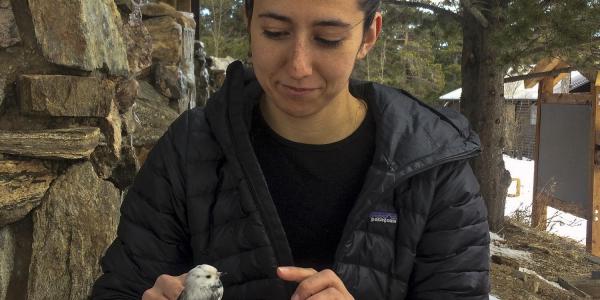To set the stage for a Western movie, the camera pans across a dusty street, showing rough wooden buildings, most notably a smithy, general store and saloon. Wind whistles between the buildings, driving spritely tumbleweeds across the street. This is the quintessential western town of the early west, when cowboys managed cattle herds.
Although tumbleweeds were familiar icons of the West, they were not native to the West, nor were they growing around the early western towns when they were established (Boulder, 1858; Abilene, Kansas, 1860; Laramie, Wyo., mid-1860s; Cheyenne, Wyo., 1867; Dodge City, 1872), for tumbleweeds were accidentally introduced from Russia to South Dakota in a contaminated shipment of flaxseed in 1873.

Russian thistle, also known as tumbleweed, growing on the bank of the Paria River in Utah. Click here to see larger image. Photo by Jeff Mitton.
Tumbleweeds are a group, not a single species. The most familiar and probably the most common in the West is Russian thistle, Salsola tragus, the first introduced. But currently seven species of Salsola are in North America, none are native and all are referred to as tumbleweeds. In addition, molecular studies have identified two distinct genetic forms of S. tragus in California, indicating that Russian thistles were introduced multiple times, from different places.
Furthermore, other unidentified — meaning they have no official names yet — species have been found. Most tumbleweeds are diploids, with two copies of each chromosome, but recently triploid (three copies), tetraploid (four copies) and hexaploid (six copies) lineages have been discovered.
Tumbleweed is also a term referring to a seed dispersal system, employed by multiple groups of unrelated species. Our tumbleweeds are annuals, growing from a seed to round globe 3 to 5 feet tall in a single year.
As the seeds mature, the entire aboveground portion dries out and breaks from the root at the soil surface. When the wind catches the light globe of stems, it sends the entire plant — including stems, prickles and seeds — rolling and bouncing across the landscape. Initially, the dry plant has about 2,500 seeds, but seeds are scattered as the desiccated weed rolls and bounces along.
Tumbleweeds are commonly seen in arid sites in the West and they become dominant in overgrazed sites. They are generally considered to be a nuisance, and occasionally become hazardous. I remember photos on the evening news showing a large freight truck stranded on a highway in a sea of tumbleweeds, with so many packed beneath it that it could no longer move — skeletons of weeds had shut down an interstate.
Tumbleweeds have occasionally piled up to the roofs of houses, blocking doors and windows and causing fire hazards. Tumbleweeds driven by high winds caused so many problems that a state of emergency was declared in El Paso and Pueblo counties in 2014.
Cows and wildlife do not eat the mature plants, even when they are still green. One of the tumbleweeds is a hyperaccumulator of cadmium, meaning that the plant preferentially takes up cadmium from the soil and accumulates it in leaves and stems. Mature plants also synthesize high concentrations of oxalates. Both cadmium and oxalates are carcinogens, and calcium oxalate forms kidney stones.
I was disappointed to learn that tumbleweeds were not natives in the west. But then, neither were cowboys nor the cows that they rustled and wrangled."
Tumbleweeds are not all bad. Bison, mule deer, elk, pronghorn and cattle can consume them in moderate amounts when the plants are young and green, before the chemical defenses are fully established. Furthermore, they were one of the last plants growing during the Dust Bowl (1930 to 1936), when many farmers and ranchers were unable to keep anything growing to feed cows and horses. Russian thistle hay is credited with saving the beef cattle industry when other sources of hay disappeared.
Tumbleweeds are firmly established in all 48 of our contiguous states, and in many places they displace native species, invade fields and pastures, pile up against buildings and accumulate in other places where they are unwelcome. Managers have been exploring methods to control tumbleweeds and a variety of biocontrols are being tested. Among these are a mite, two species of moths, a stem-boring insect, a defoliating insect and two species of fungus. One of the obstacles that managers face is that tumbleweeds are seven named species and three more unnamed species — that is a lot of targets to control.
I was disappointed to learn that tumbleweeds were not natives in the west. But then, neither were cowboys nor the cows that they rustled and wrangled.



